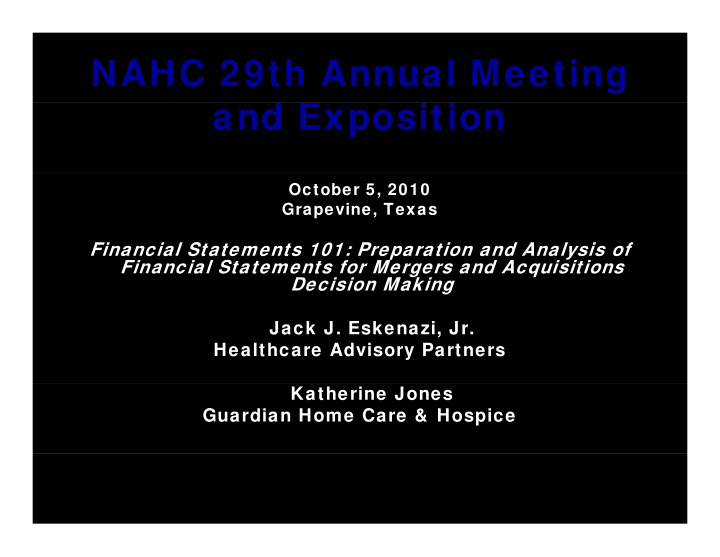



NAHC 29th Annual Meeting and Exposition October 5, 2010 Grapevine, Texas Financial Statements 101: Preparation and Analysis of Fi i l St t t 101 P ti d A l i f Financial Statements for Mergers and Acquisitions Decision Making Jack J. Eskenazi, Jr. Healthcare Advisory Partners Katherine Jones Guardian Home Care & Hospice
O Overview i • Comparative Analysis p y • Financial Statements • Application
Wh i thi i Why is this important? t t? • Professional Management g • Comparative Analysis • Valuation Underw riting etc • Valuation, Underw riting, etc…
Apples to Apples Apples to Apples Analysis • GAAP – Generally Accepted Accounting Principles Accounting Principles • Cash or Accrual Basis of A Accounting ti • For Maximum Clarity and For Maximum Clarity and Credibility
Cash Basis of Cash Basis of Accounting • Greatest strength - simple! • Report income w hen received R t i h i d • Report expenses w hen paid • Report expenses w hen paid • Greatest w eakness – can be very y misleading!
Accrual Basis of Accrual Basis of Accounting • More accurately reflects revenue and expenses for home p health agencies by matching revenue and related costs
Cash vs. Accrual Example • Claims and Collections – RAPs billed and collected in January - $1000 – Final claims billed and collected in March March – Days in Episodes • 16 days in January • 16 days in January • 28 days in February • 16 days in March
Cash vs. Accrual Example • Payroll – January: $250 earned, paid 2/15 y $ , p – February: $500 earned • $250 paid 2/28 $ p • $250 paid 3/15 – March: $250 earned, paid 3/31 , p
Cash vs. Accrual Example • Supplies – Ordered and received in January – $500 bill received in February – $500 paid 3/10 • Supplies Used – January: $50 – February: $100 – March: $250
C Cash Basis Example h B i E l January January February February March March Total Total $1,000 $-0- $668 $1,668 Revenue Direct costs Payroll $(500) $(500) $(1,000) Supplies S li $(200) $(200) $(200) $(200) Net income Net income $1 000 $1,000 $(500) $(500) $(32) $(32) $468 $468
A Accrual Basis Example l B i E l January February March Total Revenue $445 $778 $445 $1,668 Direct costs Payroll $(250) $(500) $(250) (1,000) S Supplies li $(50) $(50) $(100) $(100) $(50) $(50) $(200) $(200) Net income Net income $145 $145 $178 $178 $145 $145 $468 $468
Key Financial Key Financial Statements • Balance Sheet • Statement of cash flow s • Statement of ow ners’ equity • Statement of ow ners equity • Operating Statement (P& L)
Key Financial Key Financial Statements • Sources of Financial Data • Range of Financial Statements
Balance Sheet • Accounts receivable • Supplies Inventory Supplies Inventory • Accounts payable • Accrued expenses A d
Balance Sheet • Enterprise Value is Not Book Value p • Snapshot of Financial Condition • Strength or Weakness of Negotiating St th W k f N ti ti Position • Working Capital W ki C it l
Wh P& L? Why P& L? • EBITDA • Size, Trends, Margins Si T d M i • Business Mix, Geography, Business Mix, Geography, Management Depth
P& L: Top Line to P& L: Top Line to Bottom Line • The Top Line • Above and Below the Line Above and Below the Line • The Bottom Line
O Operating Statement ti St t t • Revenue/costs by payer • Revenue/costs by service line Revenue/costs by service line • Direct cost ratio to revenue • Direct costs by discipline Di t t b di i li • Administrative expenses • Actual versus budget
R Revenue Recognition R iti • When Cash Received • When Revenue is Earned Wh R i E d – When visits performed (non-episodic) – Evenly over 60-day episode
M& A C M& A Considerations id ti • Reliable Revenue • Business Mix Business Mix • Trend
P& L: Above and Below the P& L: Above and Below the Line • Gross Profit • Revenue – Direct Expenses Revenue Direct Expenses • Buyer Valuation Model
P& L: Above and Below the P& L: Above and Below the Line • Above the Line – costs directly related to Patient Care – Employee/Contract Labor – Mileage Mileage – Benefits – Medical Supplies Medical Supplies
P& L: Above and Below the P& L: Above and Below the Line • Below the Line - Costs not directly related to Patient Care y – Administrative salaries – Mileage Mileage – Benefits – Rent Rent
P& L: The Bottom Line • Revs-Direct=GP • GP-Admin=Net Income GP Admin Net Income • EBITDA • Adjusted EBITDA Adj t d EBITDA
Adjusted EBITDA • Pro Forma, not Projection • Positive Adjustments Positive Adjustments • Negative Adjustments
Who Will Use the Who Will Use the Financials? • Bankers • Vendors Vendors • Investors • Credit agencies C dit i • CMS • Most important – YOU
C Conclusions l i • Financial Analysis Necessary to Ensure that Margin Supports Mission • GAAP/Accrual Necessary for Comparable Analysis • P& L/EBITDA • Must Be In Context
Recommend
More recommend